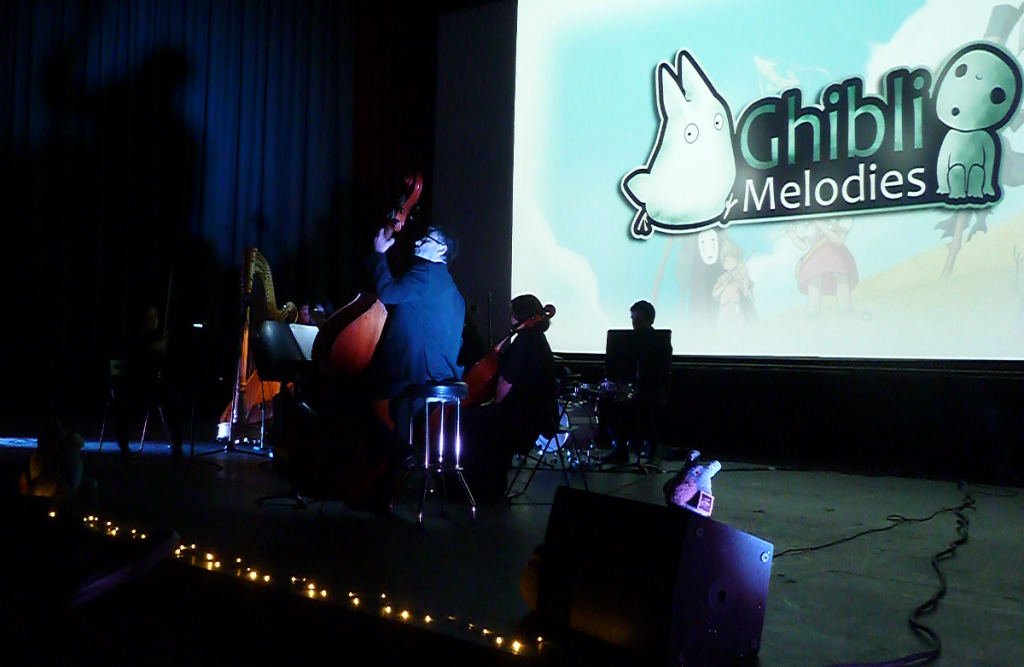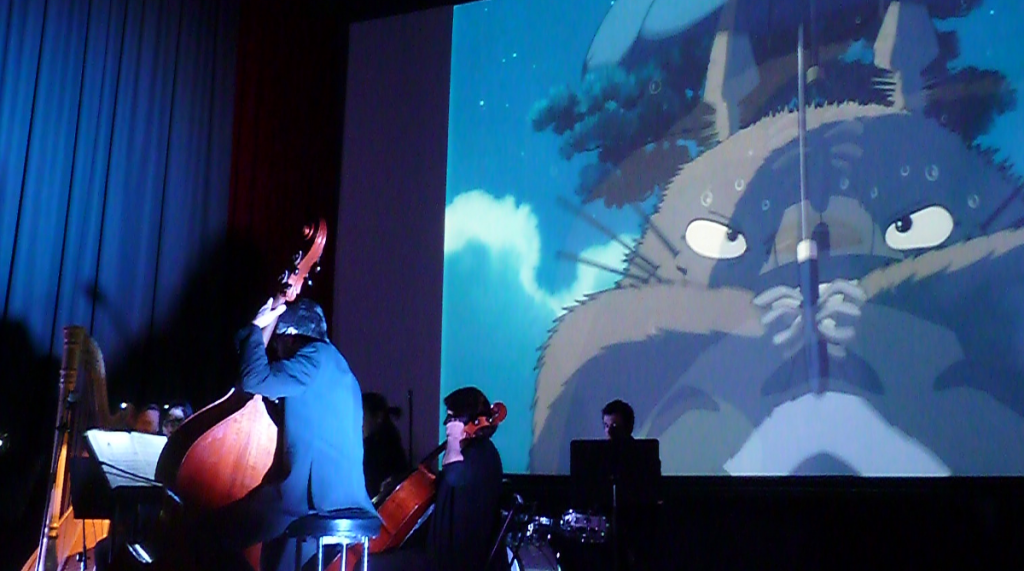Avignon
9 February 2018
 As is only to be expected, a screening of selected scenes and scores from Studio Ghibli‘s extensive catalogue of films turns out to have attracted a suitably cosmopolitan audience of all ages and subcultural inclinations to this latest ciné-concert at the hiply bohemian Pandora Cinema. Sold out in advance, the queue for the doors stretches around the corner from the self-proclaimed (with tongue firmly in cheek) “best cinema in the universe”.
As is only to be expected, a screening of selected scenes and scores from Studio Ghibli‘s extensive catalogue of films turns out to have attracted a suitably cosmopolitan audience of all ages and subcultural inclinations to this latest ciné-concert at the hiply bohemian Pandora Cinema. Sold out in advance, the queue for the doors stretches around the corner from the self-proclaimed (with tongue firmly in cheek) “best cinema in the universe”.
Before the programme begins, a number of plush toy characters from the Ghibli universe are placed behind the twinkling fairy footlights at the temporary stage front. This sets the mood nicely as the auditorium fills up to capacity, that and a selection of character drawings on sale at one side of the stage (and the harpist stepping out to tune his instrument), and the line between a film showing and a concert is suitably blurred. The Ensemble Evolutis file out to take their places onstage, including David Lozano, who was also responsible for the selection and editing of the film segments in the programme.
The greater part of the excerpts shown tonight are from works directed by Hiyao Miyazaki, doyen and founder of Ghibli, and while the obvious favourites are plentifully represented, there are several less well-known titles chosen for the ensemble to play along to. The programme opens with the wolfish pastorale of Princess Mononoke, the deer-populated mountainous landscape of a legendary Japan where the action unfolds, the motion often held to sombre still images of the hornèd llama-like creatures ridden by the heroes during their adventures, magical sword fights and all. Throughout, Tamiya Terashima and Joe Hisaishi‘s compositions are never mawkish, always pleasant, poised, equally able to express danger, drama and the subtler emotional nuances with a suitably cinematic panache. However, the selection played by the ensemble can rarely fit the scenes onscreen exactly, given the separation of the music from its original context, and the choice of edited highlights from each film last ten minutes or so at most.
Throughout, Tamiya Terashima and Joe Hisaishi‘s compositions are never mawkish, always pleasant, poised, equally able to express danger, drama and the subtler emotional nuances with a suitably cinematic panache. However, the selection played by the ensemble can rarely fit the scenes onscreen exactly, given the separation of the music from its original context, and the choice of edited highlights from each film last ten minutes or so at most.
The evening is not one just for the hardcore Ghibli fans, and the ensemble play along to the fantastical and well-beloved scenes on screen with diligent aplomb. As the parade of mechanical marvels and mysterious beasts flicker by in a medley of music and magic. Howl’s Moving Castle steps clunkily through the misty alpine meadows, the hopping scarecrow accompanied by a sprightly trickle of mellifluous strings that lighten the mood, while the living fire-demon Calcifer that keeps the castle alive is counterpointed by the brightly sparkling flute and swinging percussive motifs.
Then there’s Kiki on her flying broom, accompanied by a lighter, more comedic harp and flute duet, in stark contrast to the strident drumbeats that raise the tension again for Nausicaä of the Valley of the Wind, its flying-wing bombers and images of science fantasy constructions engulfed by total warfare. Again, the video montage often stops the action to concentrate on still images before the frenetic movement returns, and the ensemble match the violence with a highly emotive rendition of the score, rising and falling with the onscreen drama, and they play well and with admirable restraint.
There’s treasure to be found inside the bamboo harvest of the quintessentially Japanese brushwork brought to magnificent life in The Tale of the Princess Kaguya. As the snow covers the beautifully rendered land, so the score matches the elegantly minimal cinematic storytelling in a perfectly judged blend of music and imagery that springs into joyful life, cherry blossom blanketing the ground in a counterpoint to the earlier snowfall. With the music as the focus, the evening necessarily takes on the feeling of a greatest hits performance — but given the stupendous quality of the Ghibli oeuvre, that’s no bad thing at all. As full of wonder and occasionally guileless — though never naïve or saccharine — as the films, this may rarely be over-demanding music, but the ensemble perform with a deftness and a genuine warmth for the task at hand. This helps give the evening a sense of gentle occasion and makes for a fitting tribute to a remarkable film studio which has maintained a real sense of magic and wonder in almost everything it has released.The musical moods shift further, from from the pizzicato folk tunes that accompany Sparrowhawk as he travels through the adaptation of Ursula K Le Guin‘s Tales From Earthsea, meeting dragons and other wonders, to the flying boats and fabulous vistas of Porco Rosso, realised energetically as Hisaishi’s almost comedic soundtrack sparks up the mood once more. The stunning animation of the seaplane race is matched by percussive action, dancing brightly and vividly to accompany one of Miyazaki’s favourite things, vintage aircraft held together by sticks and string, contraptions that the ensemble’s instruments echo offscreen in a delightful combination that deserves its warm applause.
Spirited Away is often one of both Miyazaki and Ghibli’s more sinister stories, a tour de force of magicians, spa-taking demons from the shadow world, and of course, plenty of dragons. The strings well up in a powerful groundswell that the flute leads in to accompany the astonishing artwork of one of Ghibli’s best-loved films, and the music becomes energetic and dynamic, the strings almost bouncing off the active percussion. A moment of song comes when flautist Lynda Hagen performs the gently stirring Japanese lyrics to “Itsumo Nandodemo” (“Always With Me”) from Spirited Away, and it’s a hard heart indeed that would remain unmoved by the montage of frog-like staff of the demon spa, nor yet be un-gobsmacked by perfection of the animation and Hagen’s accomplished delivery. And of course the finale has to be Totoro, the harp plucking bountifully to accompany the parade of Ghibli characters, bursting with invention and childlike enthusiasm for the joys of the world. So too is the music, and together they form a natural highpoint of the evening, setting off various audience members whistling the tune after the last notes have faded. As the cat bus pulls away, the sprightly theme leads into a montage of the Ghibli pantheon, and there’s neat farewell moment when Porco Rosso flashes a well-timed thumbs up at just the right spot during his revisited theme as it provides the encore that the crowd rightly demands.-Richard Fontenoy-





